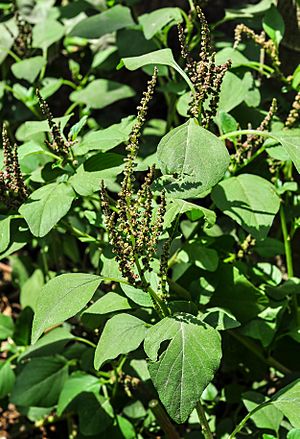Amaranthus viridis facts for kids
Quick facts for kids Amaranthus viridis |
|
|---|---|
 |
|
| Scientific classification | |
| Genus: |
Amaranthus
|
| Species: |
viridis
|
Amaranthus viridis is a common plant found all over the world. It belongs to the Amaranthaceae family, which includes many types of amaranth plants. People often call it slender amaranth or green amaranth. This plant is well-known because its leaves and seeds can be eaten.
Contents
What Does Green Amaranth Look Like?
Green amaranth is a plant that grows every year. It has a light green stem that stands upright and can reach about 60 to 80 centimeters (about 2 to 2.5 feet) tall. Many branches grow from the bottom of the plant.
Its leaves are shaped like an oval. They are usually 3 to 6 centimeters long and 2 to 4 centimeters wide. The leaves have long stems, about 5 centimeters. The plant also has small green flowers that grow in clusters at the top of the branches. These flowers have three tiny parts called stamens.
How People Use Green Amaranth
Green amaranth is a very useful plant. People eat it as a green leafy vegetable in many parts of the world.
Green Amaranth as a Vegetable
In the Northeastern Indian state of Manipur, people call this plant cheng-kruk. It is also a popular vegetable in South India, especially in Kerala, where it is known as kuppacheera (കുപ്പച്ചീര).
It is a very common leafy green in Bengali cuisine, where it is called note shak. The word "shak" means leafy vegetable. In the Odia cuisine of India, it is used as Saaga, known as Kosila Saaga or Marshi Saag in villages.
People in parts of Africa also eat green amaranth as a vegetable. In the Maldives, the leaves are called massaagu in Dhivehi. They have been a part of the Maldivian diet for hundreds of years, used in dishes like mas huni. In West Africa, the Yoruba people call this plant Ewe Tete. They use it for traditional medicine and spiritual practices.
Green Amaranth in History
In the 1800s, green amaranth was also a food source in Australia. A botanist named Joseph Maiden wrote about it in 1889. He said it was a great replacement for spinach and much better than some other greens sold in Sydney. He compared it to boiled nettle leaves, which were eaten in England. Maiden believed that once more people knew about green amaranth, it would become very popular.
Edible Seeds of Green Amaranth
Besides the leaves, green amaranth also has small, nutty seeds that can be eaten. These seeds grow in clusters. You can eat them as snacks or use them to make biscuits. If you boil the seeds in water, you can make a porridge. It's easy to collect the seeds by gently rubbing the ripe seed clusters between your fingers.
Medicinal Uses
Amaranthus viridis is also used as a traditional medicine. In Ayurvedic medicine, which is an ancient Indian healing system, it is known by the Sanskrit name Tanduliya.
Nutrition Facts
Green amaranth is very nutritious. Its dried leaves can contain up to 38% protein. Both the leaves and the seeds have an important nutrient called lysine. Lysine is an essential amino acid, which means our bodies need it but cannot make it themselves.
Plants Like Green Amaranth
There is another plant that is very similar to Amaranthus viridis and is also eaten. It is called Amaranthus blitum. In Jamaica, this plant is known as callaloo. In Greece, people call it vlita.
See also
 In Spanish: Amaranthus viridis para niños
In Spanish: Amaranthus viridis para niños

